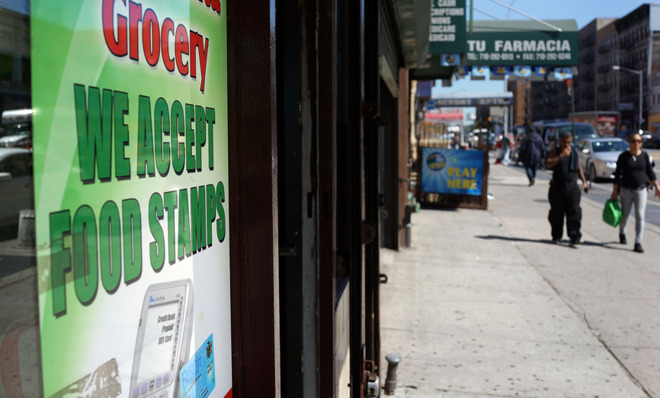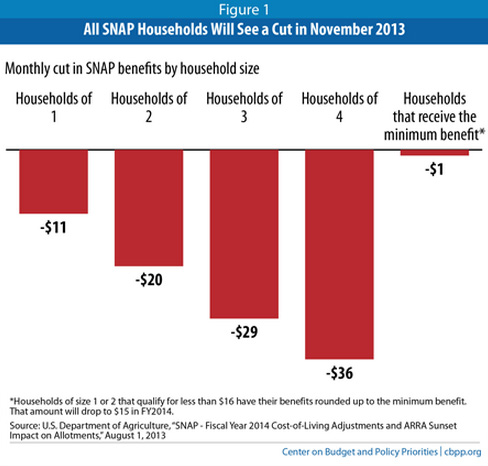What $36 means to a family on food stamps
Today, $5 billion in food stamp funding expires. And more cuts could be on the way.

Starting today, families who depend on food stamps will see their benefits cut as $5 billion in funding for the Supplemental Nutrition Assistance Program (SNAP) expires.
That means 47 million people — one out of seven Americans — will have to make do with less. And those aren't even the only cuts coming to SNAP. That $5 billion came from stimulus spending passed in 2009. Eventually, Congress will pass a new farm bill with revised SNAP spending. House Republicans are looking for $49 billion in cuts, and the Senate has already agreed to cuts of $4.5 billion.
So, what does $5 billion mean for the average family on food stamps?
The Week
Escape your echo chamber. Get the facts behind the news, plus analysis from multiple perspectives.

Sign up for The Week's Free Newsletters
From our morning news briefing to a weekly Good News Newsletter, get the best of The Week delivered directly to your inbox.
From our morning news briefing to a weekly Good News Newsletter, get the best of The Week delivered directly to your inbox.

Let's take a look at a family of four. Starting this month, they will get about $36 less in food assistance. That might not sound like a lot to people in the middle class. But to qualify for SNAP in the first place, you need to make less than $1,863 a month for a family of four (or $908 for an individual). Note that these are upper limits on net income; plenty of people who get SNAP benefits make far less.
The USDA offers four food budgets, ranging from "thrifty" to "liberal." Its strictest budget recommends spending only $1.70 to $2 per meal. That means a family of four now has two options: Eat 21 fewer meals a month, or lower spending to less than $1.40 per person per meal, according to the Center on Budget and Policy Priorities.
"The idea that people can make up for this by shopping differently just isn't realistic," Joel Berg, director of the New York City Coalition Against Hunger, told the New York Daily News. "They can't and they won't. They'll go hungry and have less food."
And the foods they will be pushed toward probably won't be fresh fruits and vegetables. In the United States, poverty tracks strongly with obesity, which is why, The Atlantic's Chin Jou argued earlier this year, the cuts will be particularly devastating:
A free daily email with the biggest news stories of the day – and the best features from TheWeek.com
Households affected by these SNAP cuts will have to contend with desperately tight grocery budgets that will constrain their ability to buy healthy food, making it easier for them to become obese. Having less money to spend on food could prompt SNAP recipients to buy more calorie-dense, nutrient-poor foods that contribute to both weight gain and malnourishment. With the exception of a few items like beans and potatoes, many of the cheapest grocery offerings are highly processed foods packed with health advocates' maligned trinity of salt, sugar, and fat. [The Atlantic]
One alternative to SNAP are food banks and private charities — but many of them claim they are overwhelmed. Jan Pruitt, director of the North Texas Food Bank, claimed to KERA News that her organization nearly ran out of food last summer, and "with SNAP cuts adding to the line at a time when we're struggling to get ahead of the curve, it's just nearly impossible."
"We do not have the capacity to meet that demand," Michael Kantor, spokesman for the Second Harvest Food Bank in New Orleans, told The Times-Picayune. "Private charities simply can't fill that gap."
Rachel Sheffield of the conservative Heritage Foundation argued that the government is "not cutting the program" because the $5 billion boost "was only meant to be temporary."
Those spending levels were raised, however, because of the Great Recession, which wiped out an estimated 8.7 million jobs. The U.S. labor market, nearly six years later, still hasn't recovered.
Keith Wagstaff is a staff writer at TheWeek.com covering politics and current events. He has previously written for such publications as TIME, Details, VICE, and the Village Voice.

